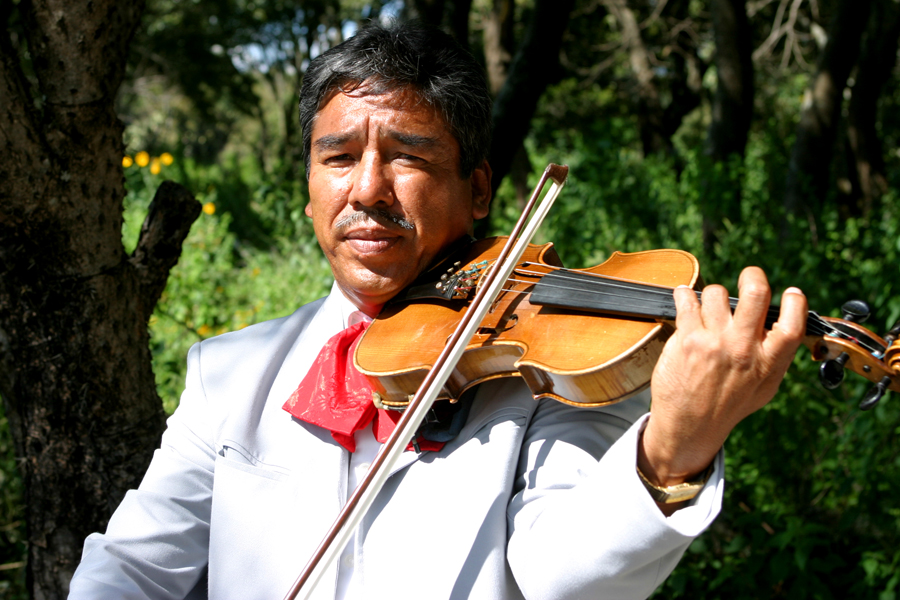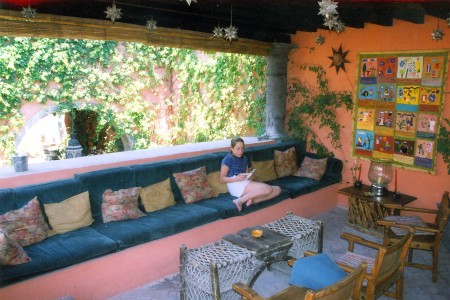So Monday afternoon I was lounging around the Starlight Lounge, the outdoor living room on the roof of my B &B, Casa Luna Pila Seca, just starting to doze off when my afternoon siesta was interrupted by the arrival of a young girl, maybe 11 or 12 years old, who didn’t think twice about throwing herself onto my lounging area even though there was plenty of room elsewhere.
As I said, she was toting a copy of J.D. Salinger’s short story collection, Nine Stories. I moved my feet away from her when she sat down but continued reading my book.
“So what do they call you?” she said.
What do they call me? I don’t think anyone has ever asked me that question. It sounds like something you’d hear in a John Ford Western, right?
“Mi nombre es David,” I said without looking up, hoping the Spanish would discourage any further conversation.
“Oh, I get it,” she said, hopping up and going over to the honor bar. “We’re going to do the hable español thing, are we?” She reached into the little fridge and pulled out a Sol. “Want one?” she asked.
“Should you really be having a beer?”
“Well, I was going to have a glass of wine,” she said, “but it’s really gross. Have you tried it?”
“No, but I noticed that someone was rude enough to leave an untouched glass out. There were bugs in it.”
She frowned. “Yeah, that was probably mine.” She put the beer back in the fridge and returned to the couch with some tangerine-flavored soda. “You’d probably tell my mom if I had a sir-vay-za, wouldn’t you?”
“Probably.”
“That’s what I thought.” I went back to reading my book but she wasn’t done with me yet. “So, Da-veed,” she said, pronouncing it in Spanish, “how long have you been in town?”
Okay, I had to laugh. First she wants to know what they call me and then she wants to know how long I’ve been in town? Was she going to ask me about my horse next?
“Un mes o tan.”
She nodded, thinking about this. “Actually, I just started taking Spanish this year,” she told me, “so I’m not that great yet. My teacher, Señora Jakowski, doesn’t actually speak Spanish herself. But my mom lets me do all the ordering at the restaurants here. And yesterday I got a pistachio helado from one of those guys in the Jardín.” When I didn’t say anything she added, “Don’t you just love saying that?”
“What?”
“Har-deen,” she said with a bit of exasperation in her voice. “I wish we had a har-deen in my town.”
“And where is that?” I asked.
She shrugged. “Well, at the moment, I guess it’s San Miguel. We were supposed to go home yesterday but my mom says we’re staying for a bit longer. Because of her new friend, Ben-ha-meen. Who she met last week in the har-deen. Ben-ha-meen is teaching her how to tango or something.”
“And where do you live?”
“At the moment, Kileen, Texas. San Diego before that. And North Carolina before that.”
“You seem to move around a lot.”
She shrugged. “My mom has absolutely the worst taste in men, if you know what I mean.”
I didn’t, but I could see where she was coming from.
“So what do they call you?” I said.
She shrugged. “I like to mix it up,” she said. “When I was little and we lived in Oceanside I was Muriel. I’ve also been Rose and Lily. I went through a flower phase for awhile. In Fayetteville they called me River. I liked that, though I think Muriel was probably my favorite.”
“And who are you now?”
“Zooey.”
I nodded towards the book in her lap. “Like Franny and Zooey?”
“Nope,” she said. “Like Zooey Deschanel the actress. My mom says I look just like her.”
I nodded. “You like that book?” I asked her.
“This book?” she asked, holding up the Salinger as if it had just fallen into her lap. “Yeah, it’s okay.” She opened it up and started reading out loud. “”Here comes a wave,” Sybil said nervously.
“”We’ll ignore it. We’ll snub it,” said the young man. “Two snobs.””
“That’s pretty good,” said the girl. “And I like how she calls the man See more glass. Instead of Seymour Glass. That’s funny.”
“Do you know who Zooey Deschanel was named after?” I asked her.
She shrugged. “Nope.”
“Zooey Glass. From Salinger’s other book.”
“No!” said the girl. “Really? Wait ‘til I tell my Mom that! You want to hear something really funny? My Dad’s name was Seymour.”
“Not Seymour Glass I hope.”
She shook her head. “Seymour Hoffman. But not the famous Seymour Hoffman. Not Philip Seymour Hoffman. Just Seymour Hoffman. Seymour Hoffman from Lancaster, California. Have you ever been to Lancaster?”
“I have not.”
She nodded. “Me neither. My mom says it’s an armpit and I don’t need to see it anymore than I need to see someone else’s armpit.”
“Is your dad still living there?”
“Nope. He died. When I was two.”
“I’m sorry.”
“Yeah, well, my mom says I didn’t miss much.” The girl got up, went back to the honor bar and pulled out the Sol again. “Sure you don’t want one?” she said.
“I’ll split it with you,” I said. She popped off the top and brought the beer over along with two glasses. I poured her about an inch and handed it to her.
“Well that’s kind of cheesy,” she said.
“Best I can do.”
She took the glass and took a sip. “Yuck,” she said.
“As bad as the white wine?”
“Worse. How do you drink this stuff?”
“It’s an acquired taste.”
“Well I hope I don’t acquire it,” she said.
“Me too.”
Then she grabbed her book and headed for the stairs. “Nice talking to you, Zooey,” I said.
“Muriel,” she said.
“I thought you said it was Zooey.”
She shrugged. “Yeah, well, I think I’m going back to Muriel. A girl can change her mind, can’t she?”
“Absolutely.”
With that she turned away, lightly dancing down the stairs.





Recent Comments